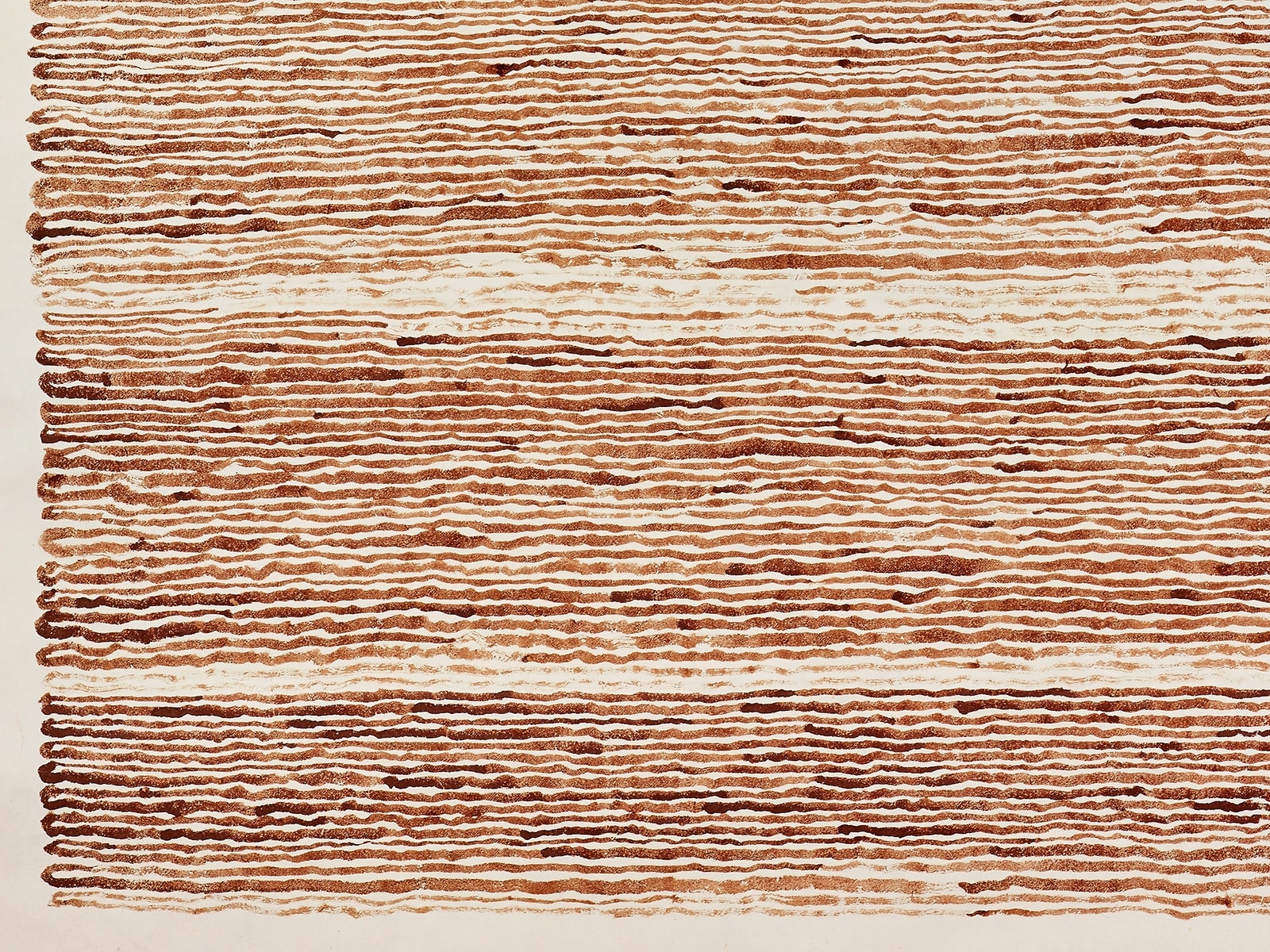Open a larger version of the following image in a popup:
 Close-up details 局部特寫
Close-up details 局部特寫
 Close-up details 局部特寫
Close-up details 局部特寫
Open a larger version of the following image in a popup:
 Close-up details 局部特寫
Close-up details 局部特寫
 Close-up details 局部特寫
Close-up details 局部特寫
Shi Jin-Hua
Six-Syllable Mantra - Chapter II, 2017
Artist's own blood on paper and audio.
214 x 147.5cm
Further images
I have been thinking about starting a project called Six-Syllable Mantra for more than a decade now. However, this project has not yet been materialized. The project was inspired by...
I have been thinking about starting a project called Six-Syllable Mantra for more than a decade now. However, this project has not yet been materialized. The project was inspired by a monk in the Ming Dynasty named Haiyu Wuxia. He resided in Jiuhua Mountain for more then 20 years and completed the Avatamsaka Sutra by writing the 81 rolls with the blood from his tongue and gold dust.
Six-Syllable Mantra was intended to be done by using a Chinese writing brush and my own blood to paint horizontal lines on cotton paper while reciting the Six-syllable Great Bright Mantra. Therefore, this project was audio, but did not include texts. The reason the project never materialized because it was difficult to obtain my own blood and to inject anticoagulant with other formula into blood.
Different from Pen Walking, which represents the life, Six-Syllable Mantra uses one’s body and blood to write about the directions of life. The peaceful horizontal lines as well as repeated recitations bring someone into a meditative and peaceful state. This was the way to cultivate mindfulness and the process of Samaya.
「六字書」這件作品的想法已經有了十多年,但一直沒有執行。其構想啟發自中國明代的僧人海玉無瑕。他長期住錫九華山,費時二十餘年,用舌血和金粉抄寫八十一卷《大方廣佛華嚴經》。
〈六字書〉預計只用毛筆、自己的血液在宣紙上往返不中斷的畫水平線,畫線的同時持唸「六字大明咒」並錄音。所以這件作品是有聲音,但無任何文字的。此作品遲遲無法執行的原因是,取得血液的方法、抗血凝劑及加入鮮血中配方的問題,始終無法克服。
有別於用鉛筆象徵一世身命的〈走筆〉,〈六字書〉直接用自己的身體、血液來書寫皈依身命的方向。緩緩的水平線,重複迴盪的咒音,讓人的心進入冥想與定境,這是一個鍛鍊正念與正受的過程。
◆《六字書 第二品》2017|藝術家血液、紙、聲音檔|214 x 147.5cm
Six-Syllable Mantra was intended to be done by using a Chinese writing brush and my own blood to paint horizontal lines on cotton paper while reciting the Six-syllable Great Bright Mantra. Therefore, this project was audio, but did not include texts. The reason the project never materialized because it was difficult to obtain my own blood and to inject anticoagulant with other formula into blood.
Different from Pen Walking, which represents the life, Six-Syllable Mantra uses one’s body and blood to write about the directions of life. The peaceful horizontal lines as well as repeated recitations bring someone into a meditative and peaceful state. This was the way to cultivate mindfulness and the process of Samaya.
「六字書」這件作品的想法已經有了十多年,但一直沒有執行。其構想啟發自中國明代的僧人海玉無瑕。他長期住錫九華山,費時二十餘年,用舌血和金粉抄寫八十一卷《大方廣佛華嚴經》。
〈六字書〉預計只用毛筆、自己的血液在宣紙上往返不中斷的畫水平線,畫線的同時持唸「六字大明咒」並錄音。所以這件作品是有聲音,但無任何文字的。此作品遲遲無法執行的原因是,取得血液的方法、抗血凝劑及加入鮮血中配方的問題,始終無法克服。
有別於用鉛筆象徵一世身命的〈走筆〉,〈六字書〉直接用自己的身體、血液來書寫皈依身命的方向。緩緩的水平線,重複迴盪的咒音,讓人的心進入冥想與定境,這是一個鍛鍊正念與正受的過程。
◆《六字書 第二品》2017|藝術家血液、紙、聲音檔|214 x 147.5cm
Exhibitions
2021 “Post Experimental Ink-How We Create Art”, Art Museum School of Fine Arts Nanjing Normal University, Nanjing
2018 “Cultivating through Art - 2018 Buddha's Birthday Exhibition”, Fo Guang Yuan Art Gallery, Kaohsiung, Taiwan2021「後實驗水墨—我們如何創造藝術」南京師範大學學院美術館,南京
2018「藝行者─2018佛誕特展」,佛光緣美術館總館,高雄,台灣
Publications
2013 “Shi Jin-Hua”, Mind Set Art Center, Taiwan2013 《石晉華》,安卓藝術股份有限公司,台灣



